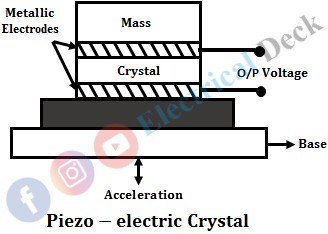The electrical device whose input will be a non-electrical quantity and gives an electrical quantity as output is known as a Transducer. The basic function of transducers is to measure non-electrical quantities like temperature, pressure, displacement, strain, light, etc. The output electrical signal obtained will be proportional to the input quantity.
There are different types of transducer that use different working principles to measure different non-electrical quantities. However, the transducers are broadly classified based on the quantity to be measured, type of output, the principle used in measurement, etc. In this let us see about Active and Passive transducers with an example for each.
Definition of Active Transducer :
The transducer which does not require any external excitation to provide its output (or for its operation) is referred to as an active transducer. In active transducers, the energy needed to generate their output is obtained from the physical parameter under measurement.
Since these transducers do not use any auxiliary source and generate their own current or voltage output, these are also known as self-generating type transducers. Some of the examples of active transducers are,
- Photovoltaic cell (it is used in light meters, solar cells)
- Thermocouple (used for measurement of temperature, radiation, and heat flow)
- Piezo-electric crystal (it is used for measurement of acceleration, vibrations, etc).
Piezo-electric Crystal :
A piezoelectric crystal used in the measurement of acceleration is shown in the figure below.
In a piezo-electric accelerometer, the crystal is placed between two metallic electrodes, and the total arrangement is attached or fixed to a base, and on the top of the crystal, a mass is placed. According to the principle called the Piezo-electric effect of a crystal, when a mechanical force is applied to the crystal it will produce an emf or voltage across it.
When the acceleration to be measured is applied to the base, the mass produces some force (on crystal) on account of acceleration. Therefore, the crystal generates a voltage that is proportional to the force exerted by mass and hence to the acceleration.
Thus, a piezo-electric accelerometer converts the input acceleration into electrical output without employing an external supply source. Therefore, it is considered to be an active transducer or self-generating transducer.
Definition of Passive Transducer :
The transducer which requires an external excitation to provide its output is referred to as a passive transducer. Since these transducers use power from an auxiliary source, they also called Externally Powered Transducers. Some of the examples of passive transducers are,
- Capacitive transducers (used to measure liquid level, noise, thickness, etc.)
- Resistive transducers (used to measure temperature, pressure, displacement, etc.)
- Inductive transducers (used to measure pressure, vibration, position, displacement, etc.).
Resistive Transducers :
One of the examples of resistive transducers is a potentiometer or POT. The potentiometer is used for linear displacement measurement. A POT excited by a voltage source Ei is shown in the below figure.
Let,- L = Total length of POT
- RL = Total resistance of POT
- Xi = Input displacement.
Then the resulting voltage at the output,
Difference Between Active and Passive Transducer :
| Active Transducer | Passive Transducer |
|---|---|
| The class or classification of transducers which doesn't require any external electrical energy for their actuation or operation are known as Active Transducers. | The class or classification of transducers that require external electrical energy for their actuation or operation are said to be known as Passive Transducers. |
| The active transducers use applied non-electrical input energy for their operation and produce an electrical output. | The passive transducers need additional electrical power for their operation to measure applied non-electrical input energy. |
| These are also called self-generating transducers. | The passive transducers are also called externally powerd transducers. |
| The energy conversion process (mechanical, chemical, thermal, or optical) is simple. | The energy conversion process is complicated. |
| It doesn't require any external power supply for the measurement. | It requires an external power supply for the measurement. |
| The resolution of active transducers is low. | The resolution of passive transducers is high. |
| The cost is low due to the simple design. | Due to its complex design, the cost of passive transducers is high. |
| The resolution cannot be adjusted, since output directly depends upon the input. | The resolution can be adjusted by controlling the external power supply given. |
| The amplitude of the output signal obtained from the active transducers is low. Hence it requires an additional amplifier at the output side to strengthen the signal. | There is no need for an amplifier at the output side for passive transducers. |
| Examples - photovoltaic cell, piezoelectric transducer, thermocouple, etc. | Examples - linear variable differential transformer (LVDT), strain gauge, thermistors, photoconductive cells, etc. |



